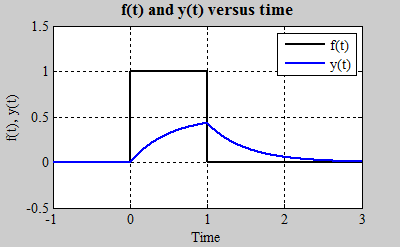
Evaluation of the convolution integral can be difficult. It is often much easier to do the convolution in the Laplace Domain and then transform back to the time domain (if you haven't studied the Laplace Transform you can skip this for now). We know that given system impulse response, h(t), system input, f(t), that the system output, y(t) is given by the convolution of h(t) and f(t).

In the Laplace domain, this integral becomes a multiplication

To see how much easier this is than performing the integral in the time domain consider the convolution integral from the previous page.
Find y(t) given:


Note: This problem is solved on the previous page in the time domain (using the convolution integral). If you examine both techniques, you can see that the Laplace domain solution is much easier.
Solution:
To evaluate the convolution integral we will use the convolution property of
the Laplace Transform:

We need the Laplace Transforms of f(t) and h(t), but we can look them up in the tables:

So

We can look up both of these terms in the tables.

We can now write y(t) (which is implicitly zero for t<0)


As you can see the Laplace technique is quite a bit simpler.
It is important to keep in mind that the solution obtained with the convolution integral is a zero state response (i.e., all initial conditions are equal to zero at t=0-). If the problem you are trying to solve also has initial conditions you need to include a zero input response in order to obtain the complete response.